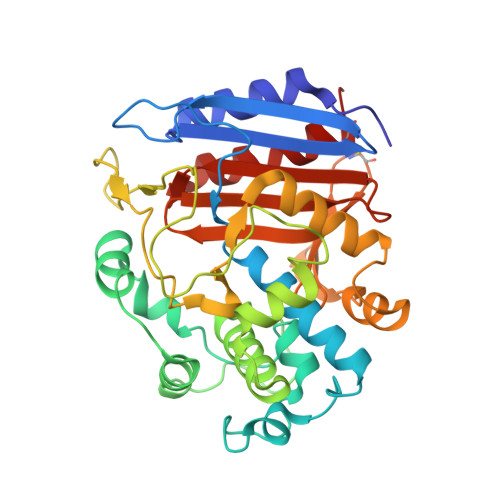The Crystal Structure of Phosphonate-Inhibited d-Ala-d-Ala Peptidase Reveals an Analogue of a Tetrahedral Transition State.
Silvaggi, N.R., Anderson, J.W., Brinsmade, S.R., Pratt, R.F., Kelly, J.A.(2003) Biochemistry 42: 1199-1208
- PubMed: 12564922
- DOI: https://doi.org/10.1021/bi0268955
- Primary Citation of Related Structures:
1MPL - PubMed Abstract:
D-Alanyl-D-alanine carboxypeptidase/transpeptidases (DD-peptidases) are beta-lactam-sensitive enzymes that are responsible for the final peptidoglycan cross-linking step in bacterial cell wall biosynthesis. A highly specific tripeptide phosphonate inhibitor was designed with a side chain corresponding to a portion of the Streptomyces R61 peptidoglycan. This compound was found to be a slow, irreversible inactivator of the DD-peptidase. Molecular modeling suggested that although a pentacoordinated intermediate of the phosphonylation reaction would not interact strongly with the enzyme, a tetracoordinated phosphonyl enzyme might be analogous to a transition state in the reaction with peptide substrates. To investigate this possibility, the crystal structure of the phosphonyl enzyme was determined. The 1.1 A resolution structure shows that the inhibitor has phosphonylated the catalytic serine (Ser62). One of the phosphonyl oxygens is noncovalently bound in the oxyanion hole, while the other is solvated by two water molecules. The conserved hydroxyl group of Tyr159 forms a strong hydrogen bond with the latter oxygen atom (2.77 A). This arrangement is interpreted as being analogous to the transition state for the formation of the tetrahedral intermediate in the deacylation step of the carboxypeptidase reaction. The proximity of Tyr159 to the solvated phosphonyl oxygen suggests that the tyrosine anion acts as a general base for deacylation. This transition state analogue structure is compared to the structures of noncovalent DD-peptidase reaction intermediates and phosphonylated beta-lactamases. These comparisons show that specific substrate binding to the peptidase induces a conformational change in the active site that places Ser62 in an optimal position for catalysis. This activated conformation relaxes as the reaction proceeds.
Organizational Affiliation:
Department of Molecular and Cell Biology and Institute for Materials Science, University of Connecticut, Storrs, Connecticut 06269-3125, and Department of Chemistry, Wesleyan University, Middletown, Connecticut 06459-0180.
















